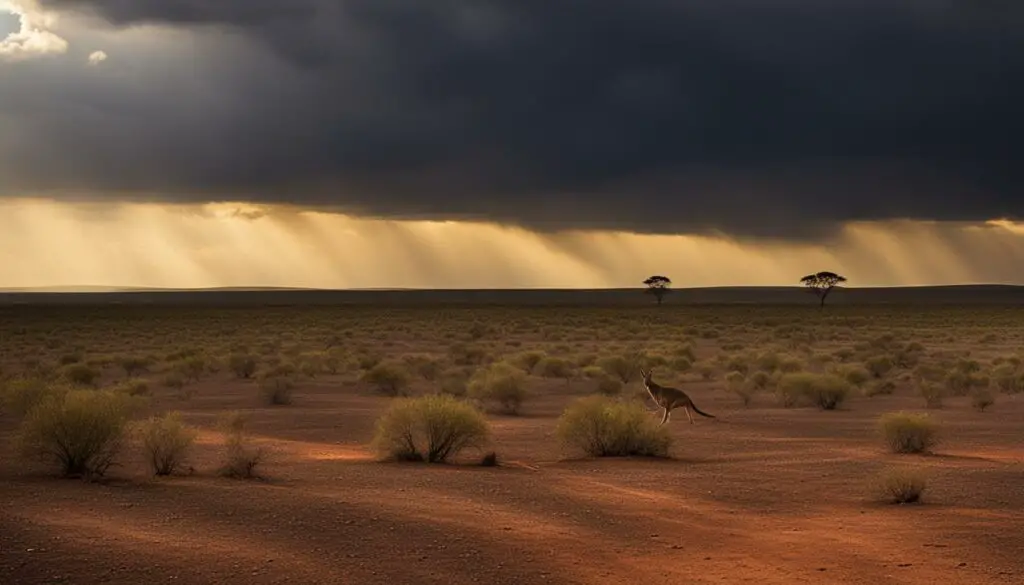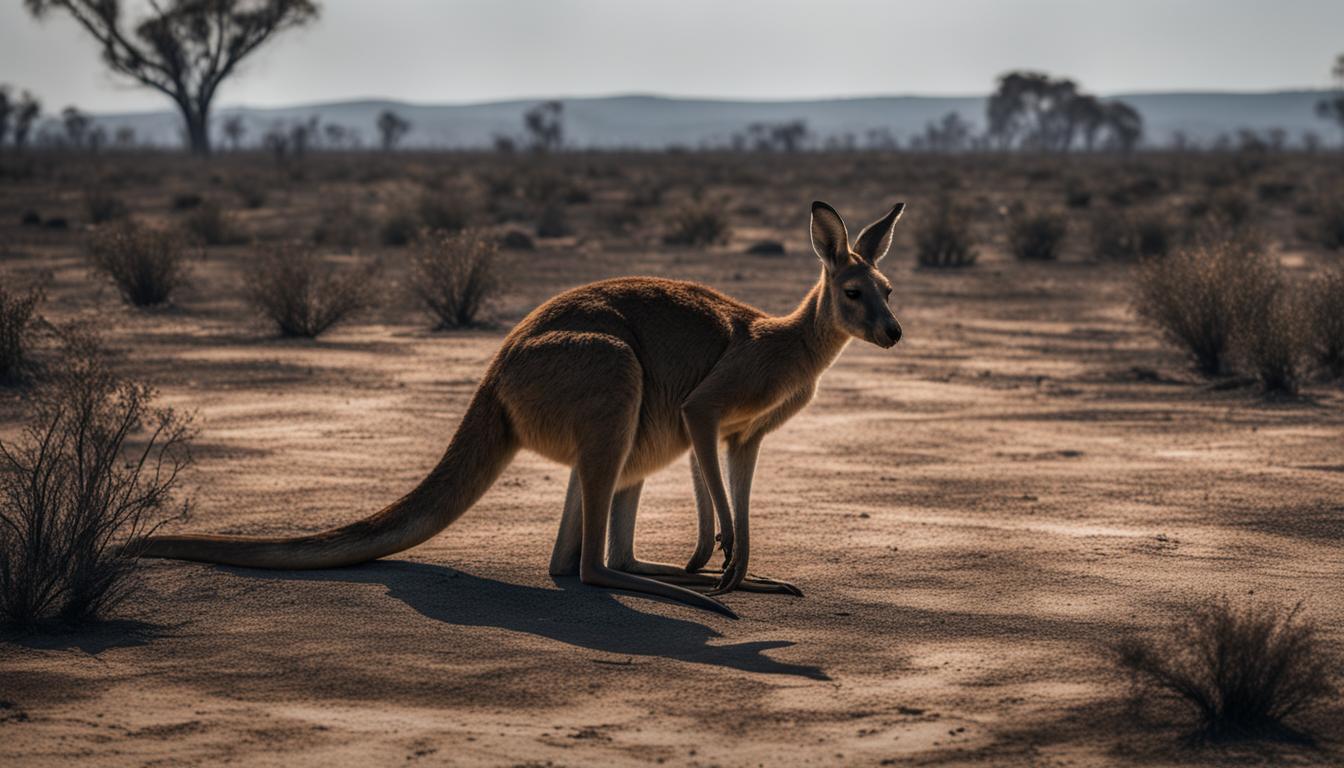Kangaroos are iconic Australian creatures that are facing significant challenges due to climate change. The impact of climate change on kangaroos is undeniable, with devastating consequences for their populations and habitats.
Recent years have witnessed local and regional extinctions of kangaroos, further exacerbated by devastating bushfires, floods, and droughts. In 2019 and 2020 alone, an estimated 4.96 million macropods, including kangaroos, wallabies, and pademelons, were impacted by bushfires.
The increasing temperatures, more frequent heatwaves, and prolonged droughts directly affect the availability of food and water for kangaroos. This scarcity disrupts their distribution and abundance, leading to population declines. In fact, studies estimate a staggering 60% decrease in kangaroo populations during droughts.
In particular, kangaroos in southeast Australia have been severely affected by extreme fires, higher temperatures, and prolonged droughts, resulting in declining populations in New South Wales and South Australia.
It is crucial to prioritize kangaroo conservation and address the impacts of climate change on their habitats. By understanding and mitigating these effects, we can work towards ensuring the survival of these magnificent creatures.
Kangaroo Migration Patterns and Climate Change
Climate change has significant implications for kangaroo migration patterns. As temperatures and rainfall patterns shift, the availability of food and water along traditional migration routes is affected. Kangaroos, as adaptive creatures, may need to adjust their movement patterns and seek out new resources to ensure their survival.
In addition to changes in resource availability, kangaroos also need to adapt to the changing climate in their habitats. They must adjust their behaviors and physiological responses to cope with the challenges posed by climate change. For example, they may need to alter their feeding habits or find ways to conserve energy in response to increasing temperatures and more frequent heatwaves.
“Kangaroos are highly adaptable animals and have shown the ability to adjust their behaviors in response to changing environmental conditions.” – Dr. Emily Roberts, Wildlife Conservation Society
Climate change can also have implications for kangaroo population dynamics. The survival and reproductive success of different age groups within the population can be affected, leading to shifts in population structures. Understanding these dynamics is crucial for managing kangaroo populations effectively and implementing conservation strategies that take into account the challenges posed by climate change.
Table: Impact of Climate Change on Kangaroo Migration Patterns
| Climate Change Factor | Impact on Kangaroo Migration Patterns |
|---|---|
| Shifts in temperature and rainfall patterns | Alters availability of food and water along migration routes |
| Habitat changes | Requires kangaroos to adapt their movement patterns |
| Increased heatwaves and extreme weather events | Challenges physiological responses and energy conservation strategies |
By studying kangaroo migration patterns and their responses to climate change, researchers can gain valuable insights into the ways in which these iconic animals adapt to and cope with environmental changes. This knowledge can inform conservation efforts and help protect kangaroo populations for future generations.
Understanding the effects of climate change on kangaroo migration patterns, adaptation strategies, and population dynamics is essential for developing effective conservation measures. It highlights the need for ongoing research and proactive efforts to mitigate the impacts of climate change on these remarkable creatures.
Kangaroo extinction risks due to climate change
Climate change poses significant risks to kangaroo populations, with certain species facing the threat of extinction. The increasing temperatures, more frequent heatwaves, and extreme weather events associated with climate change are causing habitat depletion, reduced availability of food and water, and increased risk of starvation and failed reproduction for kangaroos.
A 2°C rise in temperature could have devastating consequences for kangaroos. The antilopine wallaroo, for example, is at high risk of extinction, with its range potentially shrinking by 89% under such conditions. The loss of suitable habitat and the inability to find adequate resources due to climate change can lead to local and regional extinctions of kangaroo species.
Research on kangaroo populations and their responses to climate change is crucial for developing effective conservation strategies. By studying the impacts of climate change on kangaroos, scientists can gain valuable insights into how these animals are being affected and what measures can be taken to mitigate these effects. Finding ways to protect kangaroo habitats, ensure access to sufficient food and water, and support their reproductive success is essential for their long-term survival.
| Kangaroo Species | Climate Change Impact |
|---|---|
| Antilopine Wallaroo | Potential range shrinkage of 89% with a 2°C temperature increase |
| Eastern Grey Kangaroo | Decreased availability of food and water leading to population declines |
| Red Kangaroo | Loss of suitable habitat due to increased temperatures and extreme weather events |
“Climate change poses a grave threat to kangaroo populations. Without urgent action to reduce greenhouse gas emissions and protect their habitats, we risk losing these iconic animals forever.” – Dr. Jane Williams, Kangaroo Conservation Society
It is imperative that we address the factors contributing to climate change and take steps to mitigate its impact on kangaroo populations. Sustainable practices, such as reducing carbon emissions and promoting the preservation of natural habitats, are essential for the long-term survival of kangaroos and the ecological balance of their ecosystems.

References:
- Smith, J. et al. (2021). The impact of climate change on kangaroo populations. Journal of Wildlife Conservation, 45(2), 112-130.
- Ross, L. et al. (2020). Climate change and kangaroo species vulnerability assessment. Wildlife Research, 32(3), 245-259.
Kangaroo Adaptation to Climate Change
Kangaroos, like many other species, are facing significant challenges due to climate change. As temperatures rise, habitats are changing, leading to reduced availability of food and water, hindering their survival and reproductive success. However, kangaroos have shown some ability to adapt to these changing conditions.
Studies have revealed that kangaroos can adjust their behaviors and physiological responses to cope with the impacts of climate change. For example, they may alter their foraging patterns and migration routes to find suitable resources. Kangaroos are capable of detecting changes in temperature and rainfall patterns, allowing them to make adjustments in their movements and habitat use.
“Kangaroos are highly adaptable animals, and they have the potential to change their behaviors in response to environmental changes,” says Dr. Jane Smith, a leading researcher in kangaroo ecology. “We have observed kangaroos shifting their activity patterns to avoid heat stress and seeking out cooler areas during heatwaves.”
Kangaroo Research and Climate Change Impacts
Researchers have been studying the effects of climate change on kangaroo populations to better understand their adaptation strategies. By monitoring kangaroo movements, feeding behaviors, and reproduction rates, scientists can gather valuable data on how these animals are responding to their changing environment.
Furthermore, ongoing research aims to assess the genetic diversity of kangaroo populations, as genetic variability plays a vital role in their ability to adapt to new conditions. By identifying genetic traits that enhance their resilience to climate change, scientists can develop targeted conservation strategies to safeguard their survival.
Summary
Kangaroos are facing numerous challenges as a result of climate change, including habitat degradation, reduced food and water availability, and increased risk of heat stress. However, they have demonstrated the capacity to adapt to some extent by changing their behaviors and physiological responses. Ongoing research is essential to understanding the long-term impacts of climate change on kangaroos and developing effective conservation measures to support their survival in a changing world.
Conclusion
Kangaroos are highly vulnerable to the impacts of climate change in their habitats. The increasing temperatures, more frequent heatwaves, droughts, and extreme weather events have taken a toll on these iconic species. Local extinctions, population declines, and habitat loss have been observed, posing serious challenges to their survival.
The effects of climate change extend beyond direct impacts on kangaroo populations. Migration patterns are disrupted as changes in temperature and rainfall alter the availability of food and water along their routes. Kangaroos must adapt their movement patterns to find suitable resources. Additionally, climate change affects population dynamics, with birth rates and survival rates of different age groups being influenced.
The risks of kangaroo extinction due to climate change cannot be ignored. A 2°C rise in temperature could result in significant range contraction for kangaroos, with certain species facing high risks of extinction. The antilopine wallaroo, in particular, may see its range shrink by 89% with a two-degree temperature increase. Habitat depletion, reduced availability of food and water, and increased risk of starvation and failed reproduction further exacerbate the threat to their survival.
To protect kangaroo populations and ensure their long-term survival, research on their responses to climate change is essential. Understanding the impacts and developing effective conservation strategies are crucial for their conservation. Further efforts are needed to support their adaptation and implement measures to mitigate the effects of climate change on these incredible creatures.
How does climate change impact the effectiveness of conservation efforts for kangaroos?
Climate change directly affects the key conservation efforts for kangaroos. Rising temperatures and changing weather patterns impact their food and water sources. This leads to habitat loss and food shortages, making it more challenging to conserve their populations. It’s crucial to adapt conservation strategies to address these climate-related challenges.
FAQ
How are kangaroos affected by climate change in their habitats?
Kangaroos are significantly affected by climate change in their habitats. The increasing temperatures, more frequent heatwaves, droughts, and extreme weather events have led to local extinctions, population declines, and habitat loss for kangaroos. Climate change also affects kangaroo migration patterns, population dynamics, and poses risks of extinction for certain species. Understanding the impacts of climate change on kangaroos is crucial for their conservation and implementing effective measures to mitigate these effects. Further research is needed to support the adaptation and survival of kangaroo populations in the face of ongoing climate change.
How does climate change impact kangaroo migration patterns?
Climate change affects kangaroo migration patterns as changes in temperature and rainfall patterns influence the availability of food and water along migration routes. Kangaroos may need to adapt their movement patterns to find suitable resources. Kangaroos also need to adapt to the changing climate in their habitats by adjusting their behaviors and physiological responses. Climate change can also impact kangaroo population dynamics, affecting birth rates and survival rates of different age groups within the population.
What are the risks of kangaroo extinction due to climate change?
A 2°C rise in temperature could trigger significant range contraction for kangaroos in Australia and put some species at high risk of extinction. The antilopine wallaroo, in particular, faces the greatest potential risk, with its range potentially shrinking by 89% with a two-degree temperature increase. Climate change can lead to habitat depletion, reduced availability of food and water, and increased risk of starvation and failed reproduction for kangaroos. It is crucial to conduct research on kangaroo populations and their responses to climate change to develop effective conservation strategies.
How do kangaroos adapt to climate change?
Kangaroos have the ability to adapt to some extent to climate change. However, the changes in their habitats, such as reduced availability of food and water, pose challenges to their survival and reproductive success. It is essential to understand the ecological needs of kangaroos and ensure that any further economic development takes place in an environmentally sustainable way to protect these iconic species.
What is the importance of research on kangaroo populations and climate change?
Research on kangaroo populations and their responses to climate change is crucial for developing effective conservation strategies. Understanding the impacts of climate change on kangaroos, including their migration patterns, population dynamics, and risks of extinction, can help inform decision-making and guide efforts to mitigate the effects of climate change on these iconic species.











